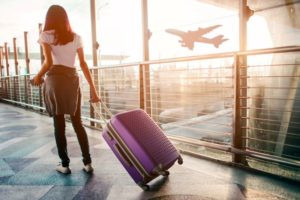 Woman pulling suitcase through airport terminal, wondering if it is safe to fly after wisdom teeth extraction
Woman pulling suitcase through airport terminal, wondering if it is safe to fly after wisdom teeth extraction
Dealing with wisdom teeth removal can be disruptive, especially when you have upcoming travel plans. If you’re scheduled for this common dental procedure and wondering “Can You Fly After Wisdom Teeth Removal?”, it’s essential to understand the guidelines to ensure a safe and comfortable journey. This article will guide you through everything you need to consider before taking to the skies post-extraction.
Understanding the Risks: Why Waiting is Often Recommended
After wisdom teeth removal, your body immediately begins the healing process. A crucial part of this is the formation of a blood clot at the extraction site. This clot is vital as it protects the underlying bone and nerves, preventing a painful complication known as dry socket.
Flying shortly after wisdom teeth removal can increase the risk of dry socket and other complications. Several factors associated with air travel contribute to this increased risk:
- Altitude and Air Pressure Changes: Cabin pressure changes during flights can affect your sinuses and the extraction site. This pressure variation can potentially dislodge the blood clot, leading to dry socket.
- Physical Activity: Travel often involves physical exertion, such as walking through airports, lifting luggage, and navigating unfamiliar places. Increased activity can divert blood flow and slow down the healing process, making you more susceptible to complications.
- Dry Cabin Air: Airplane cabins typically have low humidity levels, which can dry out your mouth and the extraction site. Dryness can also hinder clot formation and increase discomfort.
Given these factors, dental professionals generally advise against flying immediately after wisdom teeth removal.
The 48-Hour Rule: Why It Matters
The first 48 hours following wisdom teeth removal are considered the most critical for initial healing and blood clot stabilization. During this period, the risk of dislodging the clot and developing dry socket is highest.
Therefore, most dentists recommend waiting at least 48 hours after your wisdom teeth extraction before flying. This waiting period allows for initial clot formation and reduces the immediate risks associated with air travel.
Ideally, extending this period to at least one week is even more beneficial. A week allows for more substantial healing and significantly lowers the chances of complications during and after your flight. However, if flying is unavoidable, adhering to the minimum 48-hour waiting period is crucial.
Flying Within the Recovery Week: Potential Discomforts
If you must fly sooner than ideally recommended, even after the initial 48 hours, be prepared for potential discomfort during your flight. Changes in cabin pressure and altitude can still cause issues, particularly if you had upper wisdom teeth removed due to their proximity to the sinuses.
You might experience:
- Sinus Irritation and Pain: Pressure changes can aggravate your sinuses, leading to pain and discomfort that can radiate to the extraction site.
- Increased Dental Pain: General dental sensitivity and pain, which are common after extractions, can be amplified by air travel conditions.
- Headaches: Some individuals are prone to headaches during flights, and these may be exacerbated when recovering from surgery.
It’s important to be aware of these potential discomforts and take necessary precautions to manage them effectively.
Essential Tips for Flying Comfortably Post-Extraction
If flying within a week of your wisdom teeth removal is necessary, these tips can help minimize discomfort and ensure a smoother travel experience:
- Pain Management is Key: Pack over-the-counter pain relievers such as ibuprofen or acetaminophen. Take them as directed to manage pain and inflammation before, during, and after your flight.
- Gauze for Minor Bleeding: Some minor bleeding might occur, especially with pressure changes. Carry gauze pads to manage any oozing and keep the extraction site clean.
- Cold Compress On-the-Go: Bring a resealable plastic bag. Once you are through security, ask a flight attendant for ice to create a cold compress. Applying a cold compress to your cheek can help reduce swelling and alleviate pain during the flight.
- Soft Food and Hydration Essentials: Pack soft snacks like applesauce, yogurt, or protein shakes. Airport and airplane food options might be limited, and you’ll want to stick to a soft diet to avoid irritating the extraction site. Stay well-hydrated by drinking plenty of water throughout your journey.
- Maintain Oral Hygiene: Carry a travel-sized toothbrush and toothpaste. Gently rinse your mouth with saltwater (if permissible with travel restrictions on liquids or use bottled water and salt packets after security) to keep the extraction site clean and prevent infection. Avoid vigorous rinsing, which could dislodge the clot.
- Contact Your Dentist for Concerns: If you experience any unusual pain, excessive bleeding, or signs of infection while traveling, don’t hesitate to contact your dentist immediately. They can provide guidance and advice remotely or help you find local dental care if needed.
Conclusion: Fly Prepared and Prioritize Healing
While it’s generally safe to fly after 48 hours following wisdom teeth removal, waiting longer, ideally a week, is advisable to minimize risks and discomfort. If you must travel sooner, being well-prepared is crucial. By understanding the potential complications and following these tips, you can make your journey as comfortable and safe as possible, allowing you to focus on healing and enjoying your destination. Always consult with your dentist for personalized advice based on your specific situation and recovery progress before flying after wisdom teeth removal.